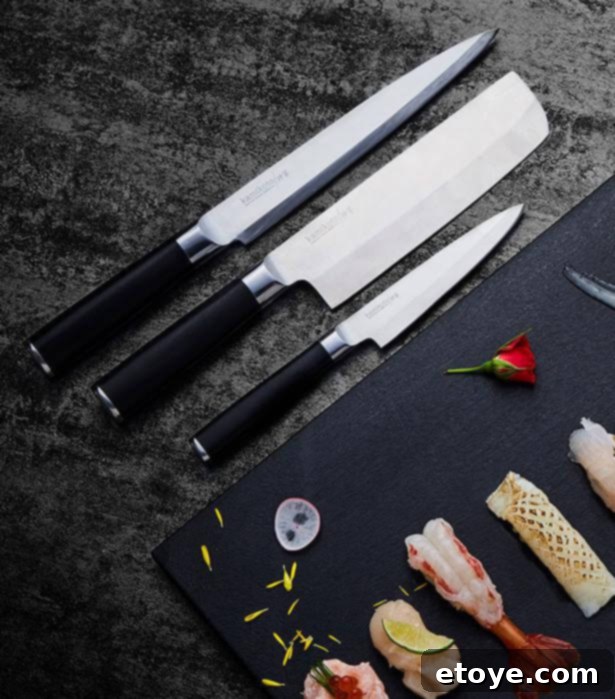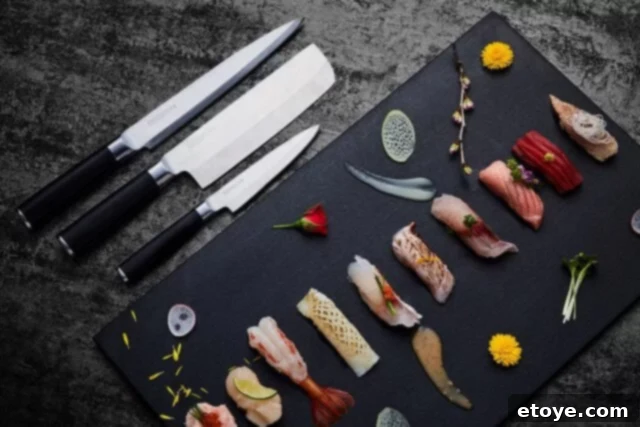
Kamikoto Knives: An In-Depth Review and Critical Analysis
Embarking on a quest for the perfect kitchen knives often leads enthusiasts down the path of renowned craftsmanship and exceptional materials. Japanese knives, with their storied history and reputation for unparalleled sharpness, frequently stand out in this search. This article provides a comprehensive review of the Kamikoto Kanpeki three-knife set, evaluating its design, performance, and the significant controversies surrounding its origins and material claims.
Initially, this review began as an assessment of the Kamikoto Kanpeki three-knife set, which typically retails for $1,295.00, after several weeks of daily use. The initial impressions were largely positive, focusing on the knives’ balance, feel, and cutting ability. However, as with any high-value product, thorough investigation is crucial. It’s imperative to address a critical update that significantly impacts the overall recommendation for these knives.
Important Update (Originally from 9/28/17): Serious concerns have been raised regarding Kamikoto’s transparency. The original reviewer reported difficulty in obtaining straightforward answers from the company and received multiple reports indicating that these knives, despite claims, are manufactured in China. Based on these revelations, purchasing Kamikoto knives is strongly not recommended. This review proceeds to detail both the initial observations and the significant discrepancies uncovered.
Evaluating the Kamikoto Kanpeki Knife Set: Initial Impressions
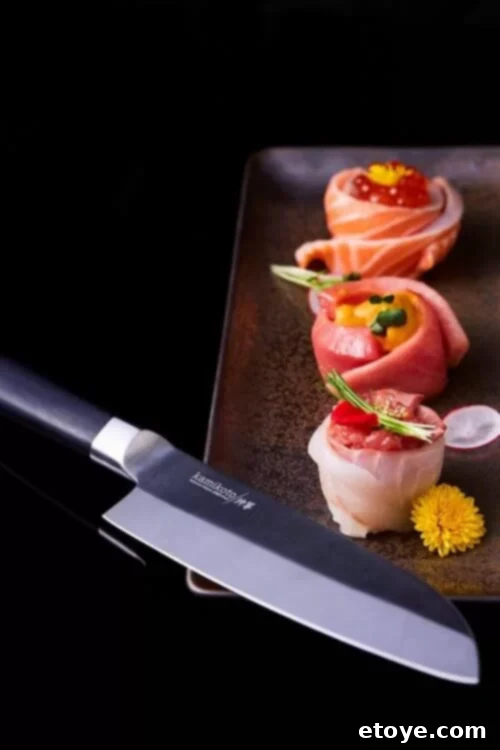
In the realm of high-end kitchen cutlery, finding a set that truly stands out is rare. Our kitchen has seen a continuous rotation of premium knives, with new arrivals often replacing current sets that are then passed on to aspiring culinary students or local non-profits. The Kamikoto set, however, initially presented itself as an exception—a collection that was difficult to part with, primarily due to its striking aesthetics and initial performance.
Kamikoto prominently markets its knives as being “handcrafted in Japan” from high-quality steel sourced from the Niigata Prefecture. Niigata boasts an impressive 800-year history of traditional knife-making, with legendary blacksmiths supposedly using secret combinations of metals to forge blades of exceptional strength and sharpness. The Kanpeki three-knife set is designed to cover a range of essential kitchen tasks, featuring a 7-inch Nakiri meat cleaver, an 8.5-inch slicing knife, and a 5-inch utility knife. These measurements refer specifically to the blade length, not the entire knife, a detail often overlooked but critical for understanding a knife’s true utility.
Kamikoto Knives: Design and Construction Analysis
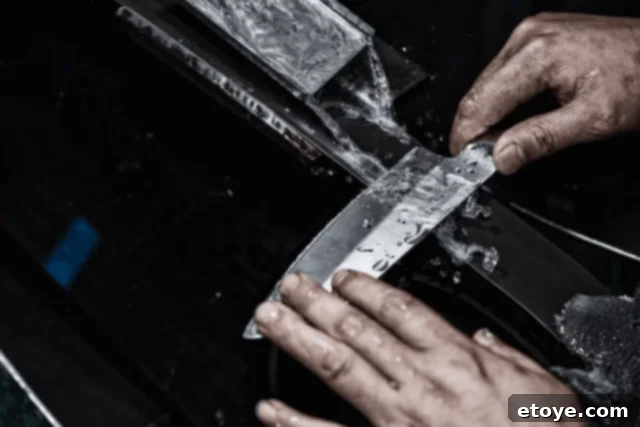
The allure of Kamikoto knives begins with their promise of precision and superior materials. Each knife is advertised as being crafted from “the highest quality Niigata Steel from Japan,” with meticulous attention paid to achieving a precision-balanced and weighted feel. This dedication to balance is often a hallmark of well-made cutlery, contributing significantly to user comfort and control.
PRO: Exceptional Balance and Feel
One of the most immediate and positive impressions was the superb balance of these knives. They possess a notable heft, often heavier than many German-made counterparts, yet their blades are slender. This combination contributes to a sensation of precise control without any hint of flimsiness. The weight feels purposeful, aiding in the cutting motion rather than hindering it, allowing for less effort during prolonged use.
The company further elaborates on its manufacturing process, stating, “In the Kamikoto forge, steel is heated up to 1050°C for three hours and annealed at 200°C for two hours. This strengthens the steel and diminishes the flexibility of the blade – to ensure the knife keeps its edge for longer.” This description paints a picture of traditional, meticulous craftsmanship aimed at producing durable, long-lasting edges.
CON: Single-Beveled Blade Design
Kamikoto knives typically feature a single-beveled edge, a common characteristic of traditional Japanese knives. While this design allows for an incredibly sharp edge and precise cuts, it can pose a challenge for users accustomed to the double-beveled edges found on nearly all German-made knives. Sharpening a single-bevel knife requires a different technique and often more specialized tools, which might be a barrier for some home cooks.
Unpacking Kamikoto Steel Hardness: Claims vs. Reality
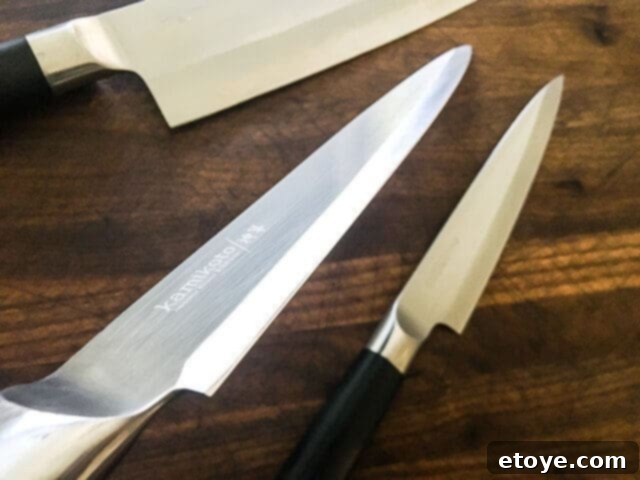
The hardness of knife steel, measured on the Rockwell scale (HRC), is a critical factor influencing edge retention and durability. Generally, harder steel retains a sharp edge for longer but is more brittle and susceptible to chipping. Softer steel is easier to sharpen and more forgiving but requires more frequent honing.
Typical Asian knives often boast a Rockwell rating of 60-61 HRC. This harder, thinner steel is highly preferred for delicate tasks like slicing vegetables, preparing seafood, and finely cutting meats for stir-fries. Their nimble, razor-sharp blades excel at precision but demand careful handling; they can chip or break if dropped on hard surfaces or used improperly. Such knives necessitate hand-washing and immediate drying and are generally not suited for heavy-duty tasks like cleaving through bone, for which a specialized, heavy Asian meat cleaver would be appropriate.
In contrast, German blades are usually thicker, heavier, and composed of softer steel, typically below 58 HRC. Their robust construction makes them ideal for tougher tasks such as cutting through large roasts, thick-skinned vegetables, and even bone. While their softer material means the edge won’t hold its sharpness as long as harder Asian knives, they are incredibly durable and can withstand considerable abuse in a busy kitchen, making them a staple for many professional chefs and home cooks alike.
CON: Discrepancy in Stated Steel Hardness
One of the most troubling findings concerning Kamikoto knives emerged from direct communication with the company. According to an email exchange, Kamikoto knives generally fall within an HRC range of 53+/-2. This rating is significantly lower (indicating softer steel) than not only most high-end Japanese knives but also many premium German brands like Wüsthof. This discrepancy is particularly alarming for knives marketed as “Japanese-made” from “highest quality Niigata steel,” as it contradicts the very characteristics expected of traditional Japanese cutlery, which rarely scores below 58 HRC. A softer steel means these knives will require much more frequent sharpening and honing to maintain their edge, challenging the initial claims of superior edge retention from their forging process.
Kamikoto Handles: Ergonomics and Durability
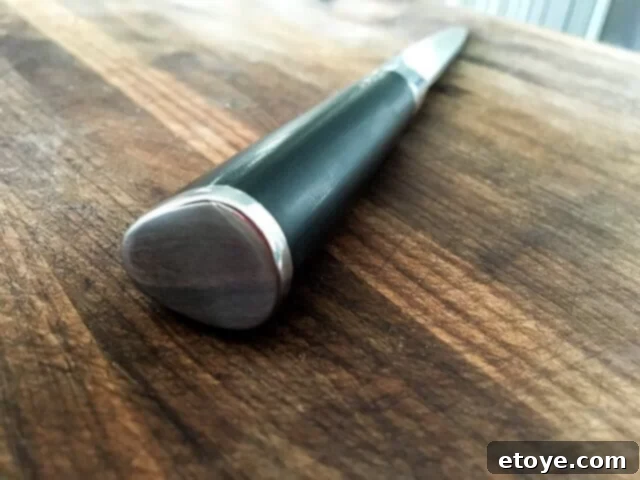
Beyond the blade, the handle is crucial for a knife’s functionality and user comfort. Kamikoto knives incorporate several design elements aimed at enhancing durability and ergonomics.
PRO: High-Durability G-10 Handles
Kamikoto utilizes G-10 for all its knife handles. G-10 is a high-durability material made from layers of fiberglass cloth and epoxy resin, which are then compressed and baked. The embedded glass fibers make G-10 incredibly tough and impervious to water. This material choice means Kamikoto handles are resistant to damage from dampness, mold, and rot—common issues with traditional wooden handles. The resin coating further ensures that the handles will not rust, oxidize, shrink, chip, become brittle, or soften over time, providing exceptional longevity and minimal maintenance.
PRO: Ergonomic Design for Superior Grip
The shape of the Kamikoto handles is thoughtfully designed for ergonomics. They are wider at the top and gently taper thinner towards the bottom, conforming naturally to the hand’s grip. The absence of harsh edges, with everything being nicely rounded, significantly enhances comfort during extended use. This design allows users to achieve a firm, solid grip, reducing fatigue and improving control.
PRO: Practical Half-Bolster Design
Another commendable feature is the half-bolster design. A bolster is the thick band of steel where the blade meets the handle. A half-bolster, as opposed to a full bolster, leaves the heel of the blade fully exposed. This design is highly favored by many chefs as it allows for sharpening and utilizing the entire length of the cutting edge, a task that full-bolster knives often make difficult and clumsy.
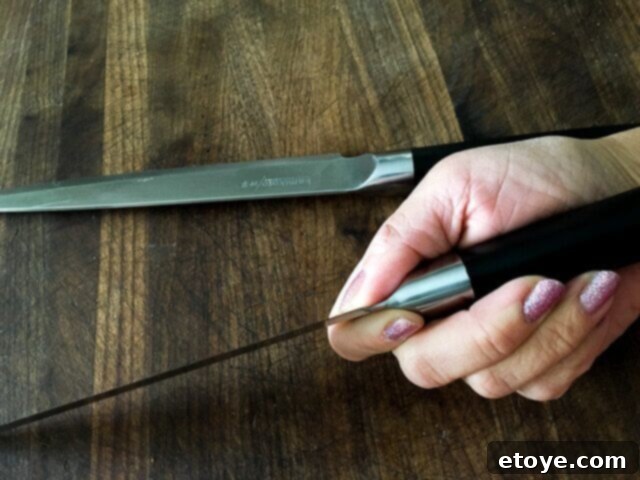
PRO: Tapered Bolster for Enhanced Comfort
Further contributing to the excellent handling, the bolster gently tapers into the handle. This seamless transition allows the fingers to wrap comfortably around the bolster without encountering any sharp edges or sudden, uncomfortable angles. This attention to detail results in a knife that feels exceptionally natural and well-fitted in the hand.
Kamikoto 7-Inch Nakiri Meat Cleaver: Versatility and Performance
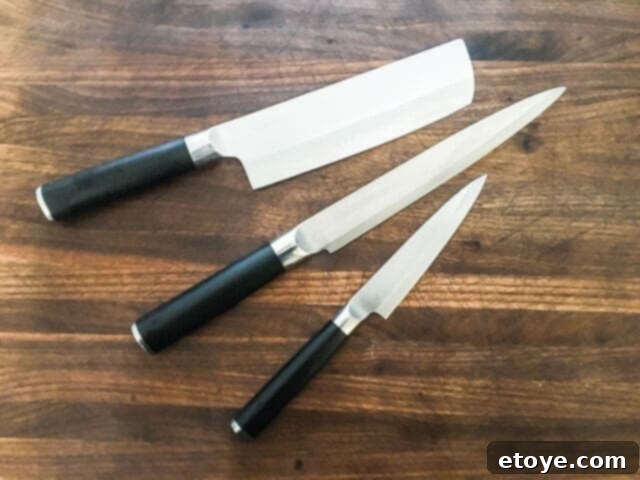
Despite its designation as a “meat cleaver,” the 7-inch Nakiri in the Kamikoto set quickly became a go-to tool for a wide range of tasks, including both vegetable and meat slicing. Its versatility in the kitchen was a pleasant surprise.
Weighing in at 9.3 ounces, this knife is noticeably heavier than many comparable chef’s knives, such as the Wüsthof Uber Chef’s Knife (7.5oz) or an ultra-light Global chef’s knife (6.3oz). However, this additional weight proved to be an advantage rather than a hindrance. The substantial feel in the hand contributes to a sense of stability and allows for more efficient cutting with less perceived effort, as the knife’s own weight assists in slicing through ingredients.
The Nakiri meat cleaver features a thicker blade profile compared to the other knives in the collection. This added thickness grants it the capability to handle slightly tougher tasks, such as cleaving through thin chicken bones or whole fish. However, it’s crucial to exercise caution and refrain from attempting to chop through larger, denser bones from pork or beef, as this could damage the blade.
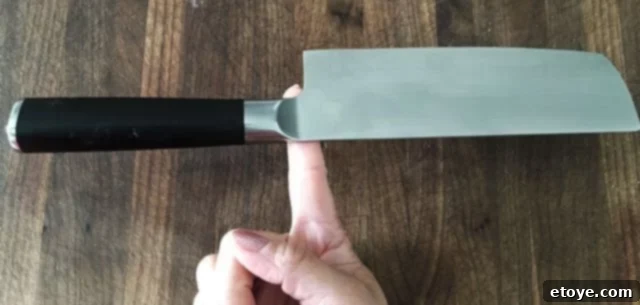
PRO: Perfect Balance for Control
A standout feature of the Kamikoto Meat Cleaver is its impeccable balance. The balance point is precisely where the forefinger and thumb naturally rest during a “pinch grip”—the recommended method for holding a knife for optimal control and safety. In stark contrast, many other knives, including some Wüsthof models, often feel handle-heavy, which can lead to fatigue and reduced precision. This perfect balance allows for exceptional maneuverability and reduces strain during prolonged prep work.
It’s important to note that this cleaver is not designed for a rocking motion typically used for chopping or mincing, as its blade lacks the necessary curve. For such tasks, a knife with a pronounced “belly” (like this Wüsthof classic chef’s knife) would be more appropriate. The Kamikoto meat cleaver excels in an up-and-down slicing motion, making it ideal for tasks like uniformly cutting bell peppers into long strips or potatoes into fries, as well as general meat slicing.
Kamikoto 8.5″ Slicing Knife: Precision and Delicacy


The 8.5-inch slicing knife in the Kamikoto set truly impressed with its remarkable precision. Its ability to perform delicate tasks with ease sets it apart from many other knives in its category. One particularly challenging kitchen task is skinning a side of fish, which demands a long, thin, and exceptionally sharp blade. Without such a tool, the flesh can be easily mangled, leaving too much valuable protein attached to the skin.
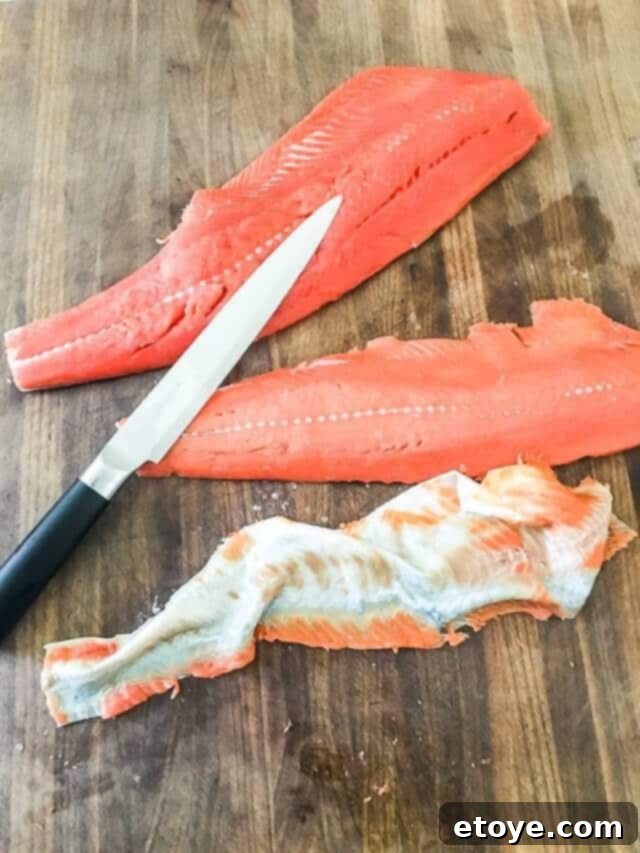
While fish skinning might not be an everyday activity for everyone, its successful execution serves as a powerful testament to a knife’s sharpness and precision. Even with imperfect skinning skills, the Kamikoto slicing knife allowed for the smooth, gentle, and effortless removal of fish skin, minimizing waste and preserving the integrity of the delicate flesh. This level of performance is highly desirable for any cook who values clean cuts and efficient food preparation.
Beyond fish, this knife is equally adept at slicing larger cuts of meat, such as a pork roast or a prime rib. Its long, slender blade allows for single, clean passes, yielding uniform slices that are essential for presentation and even cooking.
Kamikoto 5″ Utility Knife: The Everyday Workhorse
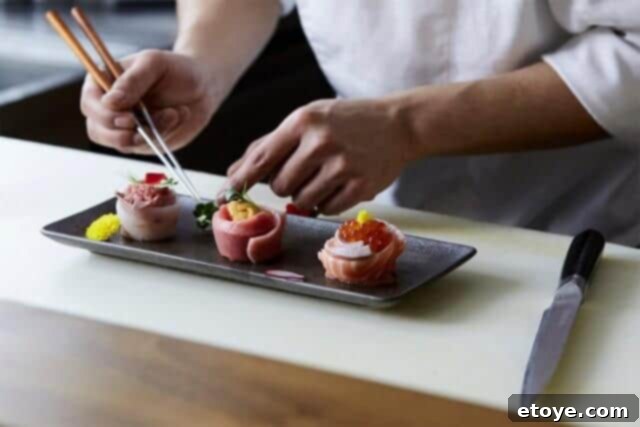
Every kitchen needs a versatile, nimble knife for a myriad of smaller tasks, and the 5-inch utility knife in the Kamikoto set fills this role exceptionally well. Often considered the most versatile knife in many sets, its compact size and sharp edge make it indispensable for daily use.

PRO: Ideal for Small-Scale Preparation
This utility knife is perfectly sized for handling smaller fruits and vegetables, such as peeling apples, dicing shallots, or trimming herbs. Its blade is notably thin, which is a significant advantage for a utility knife. A thin blade slices through ingredients with minimal resistance, ensuring clean cuts and reducing the likelihood of crushing delicate produce. This characteristic is highly valued by experienced cooks who prioritize precision in their prep work.
The Kamikoto Controversy: Authenticity and Transparency Issues
While the initial handling and performance aspects of the Kamikoto knives presented a largely positive picture, the critical update and subsequent investigations cast a long shadow over the brand’s integrity. The original reviewer’s experience of difficulty in obtaining honest answers from Kamikoto, coupled with consistent reports from multiple sources indicating that the knives are actually made in China rather than Japan, raise serious questions about the authenticity of their marketing claims. A crucial aspect of a premium product, especially one with cultural heritage claims like “handcrafted in Japan” from “Niigata Steel,” is transparency. When these claims are challenged, especially regarding the country of origin and fundamental material specifications like steel hardness (HRC), it erodes consumer trust significantly. The discrepancy in the stated HRC values, being much lower than expected for a Japanese knife, further fuels these concerns. This lack of transparency and potential misrepresentation regarding manufacturing origin and material quality is a significant detractor and warrants a strong cautionary note to potential buyers.
Final Verdict and Recommendation
The Kamikoto Kanpeki three-knife set, comprising a 7-inch Nakiri meat cleaver, an 8.5-inch slicing knife, and a 5-inch utility knife, presents an intriguing paradox. On one hand, the initial hands-on experience revealed knives with excellent balance, ergonomic G-10 handles, and impressive performance for their specific tasks, particularly the precise slicing knife and the versatile cleaver. The design elements, such as the half-bolster and tapered grip, contribute to a comfortable and controlled user experience.
However, the glowing initial impressions are severely overshadowed by the significant controversies surrounding the brand. The original reviewer’s struggle to get transparent answers from Kamikoto, combined with widespread reports of the knives being manufactured in China despite explicit claims of Japanese craftsmanship from Niigata steel, creates a fundamental breach of trust. Furthermore, the disclosed HRC rating of 53+/-2 is surprisingly low for a product marketed as high-end Japanese cutlery and directly contradicts the expected hardness and edge retention of traditional Japanese knives.
Given the retail price of $1,295, a consumer expects not only superior performance but also unassailable authenticity and transparency regarding origin and materials. The discrepancies identified make it challenging to recommend these knives. While they might feel good in hand and perform certain tasks well, the foundational issues of misleading marketing and questionable material claims undermine their value proposition. For those seeking genuine Japanese craftsmanship and quality, it would be prudent to invest in brands with a proven track record of transparency and verified manufacturing origins.
